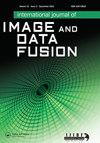基于光谱指数的亚热带湿润城市地表温度降尺度分析
IF 1.8
Q3 REMOTE SENSING
International Journal of Image and Data Fusion
Pub Date : 2023-09-01
DOI:10.1080/19479832.2023.2252818
引用次数: 2
摘要
利用2021年夏季和冬季的Landsat 8数据,分析了亚热带湿润城市降尺度地表温度(LSTs)估算误差的季节影响。热锐化(TsHARP)算法是一种基于归一化植被指数(NDVI)的最常用的降尺度技术。本研究通过四个选定的光谱指数(修正的归一化差水指数、归一化差裸指数、归一化差建筑指数[NDBI]和NDVI)的单独组合,并通过确定锐化LST产生的均方根误差(RMSE)和平均误差,来评估TsHARP技术的能力。此外,还结合四种光谱指数估算了锐化后的地表温度。NDBI提供最有效的输出(夏季RMSE为1.11 [30 m]、1.05 [120 m]、1.02 [240 m]和0.99 [480 m],冬季RMSE为0.61 [30 m]、0.59 [120 m]、0.57 [240 m]和0.56 [480 m])。基于nbi的锐化地表温度与地物的关系最佳(夏季R = 0.565,冬季R = 0.537)。休耕地与地表温度的关系最佳(夏季R = 0.512,冬季R = 0.530)。夏季(R = 0.438)地物与地表温度锐化的关系优于冬季(R = 0.409)。本文章由计算机程序翻译,如有差异,请以英文原文为准。
Analysis of spectral indices-based downscaled land surface temperature in a humid subtropical city
ABSTRACT The present study analyses the seasonal influence of error estimated in downscaled land surface temperatures (LSTs) in a humid subtropical city using Landsat 8 data of summer and winter seasons in 2021. Thermal sharpening (TsHARP) algorithm is one of the most frequently used downscaling techniques which is originally based on normalised difference vegetation index (NDVI). This study assesses the capability of the TsHARP technique with a separate combination of four selected spectral indices (modified normalised difference water index, normalised difference bareness index, normalised difference built-up index [NDBI], and NDVI), and by determining the root mean square error (RMSE) and mean error produced by the sharpened LST. Besides, sharpened LST has also been estimated by combining the four spectral indices. It is observed that NDBI provides the most effective output (RMSE is 1.11 [30 m], 1.05 [120 m], 1.02 [240 m], and 0.99 [480 m] in summer, whereas RMSE is 0.61 [30 m], 0.59 [120 m], 0.57 [240 m], and 0.56 [480 m] in winter). NDBI-based sharpened LST generates the best relationship (R = 0.565 in summer and R = 0.537 in winter) with surface features. Fallow land generates the best relationship (R = 0.512 in summer and R = 0.530 in winter) with sharpened LST. The summer season (R = 0.438) generates a better relationship between surface features and sharpened LST than the winter season (R = 0.409).
求助全文
通过发布文献求助,成功后即可免费获取论文全文。
去求助
来源期刊

International Journal of Image and Data Fusion
REMOTE SENSING-
CiteScore
5.00
自引率
0.00%
发文量
10
期刊介绍:
International Journal of Image and Data Fusion provides a single source of information for all aspects of image and data fusion methodologies, developments, techniques and applications. Image and data fusion techniques are important for combining the many sources of satellite, airborne and ground based imaging systems, and integrating these with other related data sets for enhanced information extraction and decision making. Image and data fusion aims at the integration of multi-sensor, multi-temporal, multi-resolution and multi-platform image data, together with geospatial data, GIS, in-situ, and other statistical data sets for improved information extraction, as well as to increase the reliability of the information. This leads to more accurate information that provides for robust operational performance, i.e. increased confidence, reduced ambiguity and improved classification enabling evidence based management. The journal welcomes original research papers, review papers, shorter letters, technical articles, book reviews and conference reports in all areas of image and data fusion including, but not limited to, the following aspects and topics: • Automatic registration/geometric aspects of fusing images with different spatial, spectral, temporal resolutions; phase information; or acquired in different modes • Pixel, feature and decision level fusion algorithms and methodologies • Data Assimilation: fusing data with models • Multi-source classification and information extraction • Integration of satellite, airborne and terrestrial sensor systems • Fusing temporal data sets for change detection studies (e.g. for Land Cover/Land Use Change studies) • Image and data mining from multi-platform, multi-source, multi-scale, multi-temporal data sets (e.g. geometric information, topological information, statistical information, etc.).
 求助内容:
求助内容: 应助结果提醒方式:
应助结果提醒方式:


